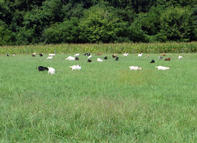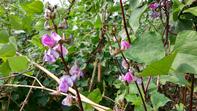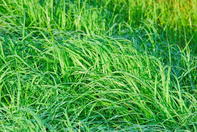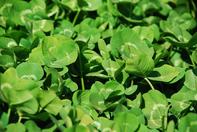
According to the Department of Forage Technology of the Agricultural Research Council (ARC), the pasture crops that are most often used for hay are weeping love grass (Eragrostis curvula) and Eragrostis tef.
For silage, maize is most often used, however, fodder sorghum is also used. The most popular summer grasses are Wool grass (Anthephora pubescens), Rhodes grass and Finger grass. Winter grasses include cock’s foot, tall fescue, oats and stooling rye.
Pasture Crops in South Africa

Legumes on the ARC’s list include dolichos bean and stylo (as summer-planted legumes) and white clover, lucerne and medics as winter-planted legumes.
Popular legume-grass mixes recommended by the ARC are Italian ryegrass-white clover, sorghum-cowpea or sorghum-dolichos bean and hairy vetch-black oats-Daikon radish combination. Any seed company will be able to advise on the best pasture crops to grow in your area and on your soil type. Ask for guidance.
Types of Pasture Plants

Pasture plants are divided into two groups - temperate and tropical pastures.
Tropical Pastures Tropical pastures are planted in summer rainfall areas in South Africa, usually in any summer rainfall month from October to February. These plants are dormant in the winter after storing nutrients in their roots during autumn, which makes them ready for new growth in spring.
A popular annual pasture plant is teff (Eragrostis tef). Teff, which is excellent for hay production, grows in all soils and can be produced under dryland conditions. For gazing fodder sorghum and pearl millet are also popular. Perennial pasture grasses include Smuts finger grass (Digitaria eriantha), Rhodes grass (Chloris gayana), Weeping lovegrass (Eragrostis curvula), Paspalum and the tasty Guinea grass (Panicum maximum), and also called white buffalo grass.
In the dryer parts of South Africa, blue buffalo grass is well adapted. In the high rainfall, cool areas or under irrigation, Kikuyu does well on fertile soils. Tropical legumes as pasture plants include species like greenleaf desmodium, perennial soybean, siratro (purple bush-bean), stylo and lucerne.
Temperate Pastures These cool-season pastures are active and green during winter and can resist frost. Compared to tropical pastures, temperate pasture plants are more tasty, nutritious and have a higher digestibility. Digestibility means how much nutrients an animal can extract from the pasture.
Examples of cool-season grasses are Westerworld and Italian ryegrass, perennial ryegrass, tall fescue and cock’s foot. Clovers - berseem clover, white and red clovers - are ideal legumes to mix with temperate grasses.
Legumes

Legumes - clovers, soybeans and peas - are plants that, through a symbiotic relationship with soil bacteria called Rhizobium, can help increase nitrogen in the soil. As pasture plants, legumes often require less fertilisation than grasses. Legumes have long taproots that penetrate deep into the soil to access moisture and has broad leaves.
In contrast, grasses have shallower roots and narrow long leaves. Examples of tropical legumes include stylo and lucerne, also called alfalfa in the USA. Examples of legumes suitable to more temperate climates are red and white clover.
Please note: Information is for educational and informational purposes only and may not be construed as feeding or nutritional advice. For more information on feeding your animals and planting crops contact your agricultural technician or seed supplier.
By Marinda Louw